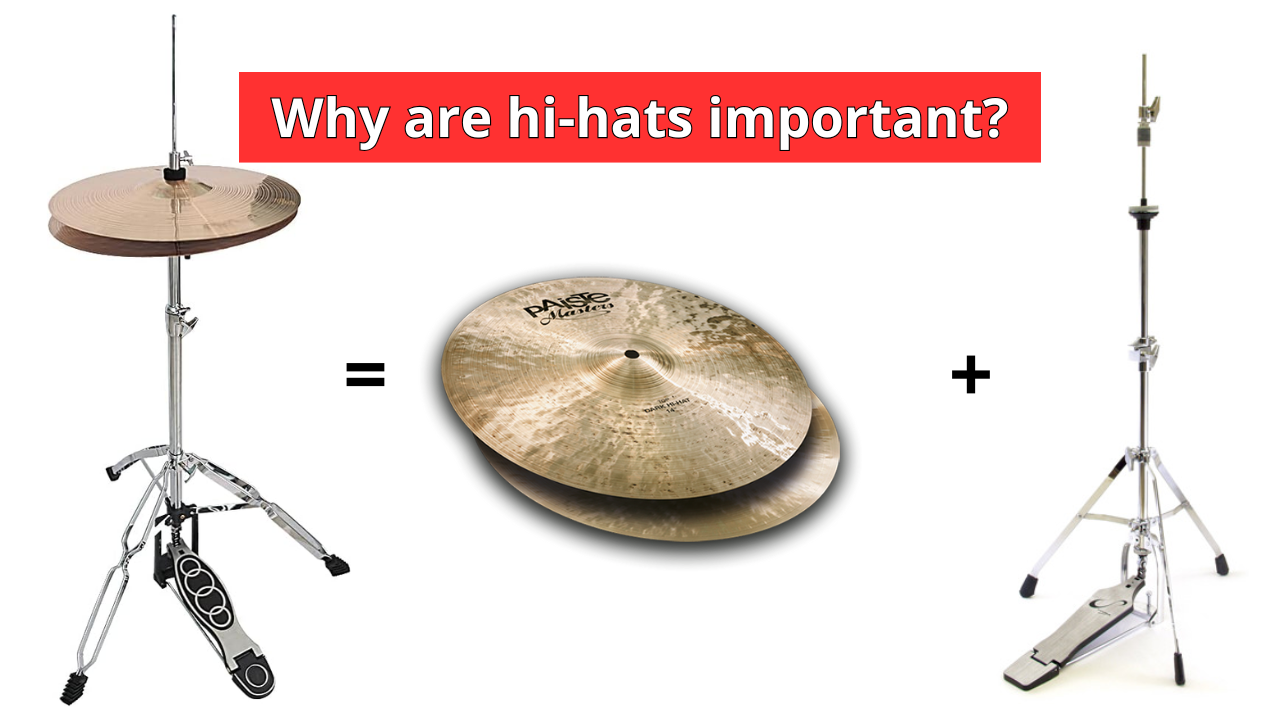In the context of percussion instruments, hi-hats serve as the foundation for many rhythmic possibilities. They can be easily recognized by their crisp sound, which establishes rhythm, and timing in any song. In this article, we will delve into how hi-hats define the drum sound, their variety, and the popular techniques used to incorporate hi-hats into drumming.

What Are Hi-Hats?
Hi-hats are a pair of cymbals mounted on a stand, controlled by a foot pedal and played with sticks, brushes, or fingers. Hi-hats keep the beat dynamic, adding interesting textures to compositions and groove. Their primary function is to add movement to rhythms and keep timing.
The rhythmic pattern produced by them can vary from rock beats to jazz patterns, proving that hi-hats are uniquely versatile instruments.These cymbals aren’t limited to specific genres as they are present in rock hits, jazz songs, orchestral music, film soundtracks, and more.
Typically, the hi-hat is placed to the left of the drummer and played with a right hand. However, today you can come across individual techniques as in the 21st century there is no single normal approach. Some drummers may use two hi-hats to avoid cross-sticking when playing the beat.
Hi-hat cymbals come in sets and are typically produced of a bronze alloy (B8, B10, or B20). Some models may also contain silver. Hi-hats are available in various diameters that impact their sound.
- 12–13 inches: These cymbals are characterized by sharp and bright sound, allowing them to perfectly work for jazz and acoustic repertoire.
- 14 inches: These hi-hats offer balanced and versatile sound and are common for rock, fusion, and pop styles.
- 15–16 inches: Such cymbals produce heavy and dark sound that makes them the best choice for metal and hard rock music.

Types of Hi-Hats
Hi-hats cymbals are divided into several options, each with its own characteristics.
Standard hi-hats
This is the most common and versatile type of hi-hat cymbals in drum sets. Their diameter varies from 13 to 15 inches. The bottom cymbal remains in the fixed position, while the top cymbal is mounted on a rod. Drummers press it against the bottom cymbal using a pedal, switching between open and closed positions.
Heavy hi-hats
Heavy hi-hats with a diameter of 14–16 inches produce a more powerful and cutting sound with defined stick articulation. These cymbals are thicker and heavier compared to standard hi-hats. They are common for loud genres such as rock, punk, and metal.
Thin hi-hats
These cymbals with a diameter of 13–14 inches are lighter than standard hi-hats, which results in a more delicate sound. As they are thinner, they are more quick, soft and responsive. Thin, also known as light hi-hats, work well for jazz genres, where musicians prefer a more controlled sound.
Dark hi-hats
Dark hi-hats of 13–15 inches produce warm and rich tones, with a lower pitch and longer sustain. Their complex sound with reduced high-end frequencies allows using them in genres where darker and atmospheric sound is desired, for instance, jazz, indie, fusion, and alternative.
Bright hi-hats
These cymbals of 13–15 inches offer crisp and cutting sound with a high pitch, short sustain, and high-frequency presence. They have a fast response with a sharp chick in a closed position and loud sizzling sound when open. These characteristics make them very clear and excellent in projection with lots of energy, making them the best choice for rock, funk, pop, and other dynamic genres where it’s important for hi-hats to cut through a dense mix.
Effects hi-hats
Effects hi-hats may vary in diameter ranging between 10–15 inches depending on the design. They produce metallic, trashy or electronic sounds and are used to add unique sounds to music. The top cymbal of the pair can feature rivets, sizzles, or jingles to produce various effects when the drummer plays it. They may also contain hybrid materials. These hi-hats are popular for experimental genres, electronic music, and creative studio recordings where there is the need for unconventional approaches.
Playing Technique on Hi-Hats
The drum sound is also defined by what specific technique the musician uses. Here are some of them:

- Double Stroke Rolls: This technique adds dynamics to grooves. The drummer uses two sticks to create quick and controlled strokes at various speeds.
- Closed Hi-Hat Playing: The drummer fully presses the pedal down, bringing two cymbals tight together, and plays the hi-hat producing a crisp and defined sound. This is the foundation for many drum patterns. It’s common for pop, funk, rock and jazz, where there is the need for precise and clear sound that adds drive to music.
- Half-Open Hi-Hat Playing: To achieve this technique, the drummer keeps the pedal slightly pressed so the cymbals remain partially open. This creates a balanced position between the closed and open options. The sound is controlled and dynamic, bringing depth to grooves. Half-open hi-hat accents are popular in reggae, blues, and alternative rock.
- Open Hi-Hat Playing: The drummer slightly releases pressure on the hi-hat pedal and lets the cymbals ring out with their full resonance. Open hi-hat playing adds intensity, laying the foundation for crescendos or climactic moments in the composition. This technique is widely used in jazz, Latin music, punk, metal.
- Foot Chick: The drummer steps on the pedal without using sticks that results in a short "chick" sound. The technique is widely used in jazz, funk, and rock for timekeeping, during snare and tom fills.
- Splashing: The drummer quickly opens and closes the hi-hats to create a washy sound.
- Barking: To achieve this technique, the drummer opens the hi-hats slightly and strikes them with a forceful stroke for a sharp, loud effect.
Conclusion
As a versatile instrument, hi-hats offer drummers many possibilities to experiment with expression, speed, and sound. By selecting hi-hats of various diameters and using multiple techniques, including double stroke rolls, closed, open and half-open playing, you can reveal your full potential as a musician and fill the music with more dynamic.
In our category of drums and percussion you can find visually appealing and reliable in terms of build and design hi-hats featuring traditional, fusion, and raw series. Recently we’ve published an article about Key Difference Between Crash, Ride, and Splash Cymbals. Feel free to check it out.



 https://kgumusic.com/pages/about-us
https://kgumusic.com/pages/about-us